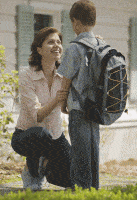
Preschoolers are open to learning numbers and letters and beginning reading and simple math; this is also a critical period for music. They’re improving their gross motor and fine motor skills, which gets them interested in art, crafts, and ride-on toys (wagons, scooters, bikes, etc.). They often participate in organized sports activities by the end of this developmental period.
The most important mode of learning during this stage is playing. Make-believe play of all kinds is attractive and fosters the development of language, socialization, and creativity. Interest in exploring their environment promotes early interest in science. Preschoolers also like to build things out of items around the house and building sets like Legos, Kinex, and blocks.
Moving Onward (Encouraging Development):
Preschooler Developmental Milestones
Three to Four Years
Gross (Large) Motor Skills
- Hops, skips, jumps and runs
- Makes sudden stops and starts
- Walks on tiptoes
- Hops on one foot
- Marches to a rhythm
- Alternates steps when climbing stairs; comes down one step at a time
- Throws ball by thrusting with arm and shoulder; catches with arms held out straight
- Swings on a swing
- Walks a low balance beam
- Rides tricycle
Fine (Small) Motor Skills
- Builds block towers of about 9 or 10 blocks
- Holds pencils and crayons with control
- Draws straight lines and copies circles
- Draws three-part person
- Cuts with scissors
- Unbuttons clothes
- Pulls up large zippers
- Uses spoon and fork
Four to Five Years
Gross (Large) Motor Skills
- Whirls around, turns, somersaults and hangs on bars
- Hops several times in a row
- Climbs large play equipment
- Jumps forward using a forward arm action
- Jumps up and down
- Throws ball overhead with less body movement
- Bounces a ball and catches the ball with elbows in front of their body
- Can hop on one foot, skip and jump
- Can catch a ball with both hands
- Can catch a beanbag
Fine (Small) Motor Skills
- Builds straight block towers
- Draws a house and person
- Prints name
- Forms crude shapes with clay
- Cuts on lines with scissors
- Brushes teeth, combs hair and washes hands
- Dresses self except for tying shoes
- Develops hand preference
- Dresses and undresses him/herself
- Can copy a simple design
- Uses scissors to cut a straight line
Five to Six Years
Gross (Large) Motor Skills
- Whirls around, turns, somersaults and hangs on bars
- Hops several times in a row
- Climbs large play equipment
- Jumps forward using a forward arm action
- Jumps up and down
- Throws ball overhead with less body movement
- Bounces a ball and catches the ball with elbows in front of their body
Fine (Small) Motor Skills
- Builds straight block towers
- Draws a house and person
- Prints name
- Forms crude shapes with clay
- Cuts on lines with scissors
- Brushes teeth, combs hair and washes hands
- Dresses self except for tying shoes
- Develops hand preference
Three to Four Years
- Knows names of familiar animals
- Can use at least four prepositions or can demonstrate his understanding of their meaning when given commands
- Names common objects in picture books or magazines
- Knows one or more colors
- Can repeat 4 digits when they are given slowly
- Can usually repeat words of four syllables
- Demonstrates understanding of over and under
- Has most vowels and diphthongs and the consonants p, b, m, w, n well established
- Often indulges in make-believe
- Extensive verbalization as he carries out activities
- Understands such concepts as longer, larger, when a contrast is presented
- Readily follows simple commands even thought the stimulus objects are not in sight
- Much repetition of words, phrases, syllables, and even sounds
Four to Five Years
- Uses possessives
- Uses double negatives
- Joins sentences
- Can answer how, who, when questions
- Follows up to 4 step directions
- Uses the third person
- Tells simple jokes
- Says their full name
- Knows an average of 900 words
- Shows rapid language development
- Uses sentences that are three to four words long
- Mispronounces 40 percent of speech sounds
- Enjoys listening to stories
- Understands more words than able to use
- Asks simple who and what questions
- Tells simple events in sequence
- Demonstrates beginning phonological awareness (hearing and recognizing the sounds of language)
- Uses words to express ideas and feelings
- Usually follows requests and can be reasoned with
Five to Six Years
- In addition to the above consonants these should be mastered: f, v, sh, zh, th,1
- Should have concepts of 7
- Speech should be completely intelligible and socially useful
- Should be able to tell one rather connected story about a picture, seeing relationships between objects and happenings
Three to Four Years
- Is curious about how things work
- Begins to understand the reasoning of caregivers
- Interested in size and shape
- Identifies colors
- Counts from one to ten
- Counts two or more objects
- Asks why questions
- Responds to how questions
- Learns their name, address, phone number, sex, age and parents names
- Holds up fingers to indicate age
- Uses bathroom words and laughs
- Enjoys doing things for self
- Develops a better understanding of cause and effect
- Distinguishes between fact and fiction
Four to Five Years
- Comprehends special concepts (e.g. around, in front, high, next to)
- Rote counts up to 2
- Can complete a 6-8 piece puzzle
- Begins to understand time concepts
- Understands simple math concepts
- Recalls main details of a store
- Improves their ability to reason
- Knows birthday
- Identifies coins such as a penny, nickel and dime.
- Understands seasons
- Begins to understand the need for rules
- Understands the concept of texture, size, distance and temperature
- Forms logical conclusions
- Enjoys games that test abilities
- Improves their ability to remember past events
- Has difficulty understanding time
Five to Six Years
- Learns right from wrong
- Accepts rules; but doesn’t always understand reason
- Enjoys routines
- Exhibits increased attention span and concentration
- Follows instructions concerning numbers
- Understands terms like more than and less than
- Uses many words without understanding definitions
- Understands simple classifications such as groups of trees and animals
- Places blocks and nesting toys in order (small to large)
- Asks a lot of questions, especially, “Why?”
Three to Four Years
- Becomes less self-centered
- Is sunny and agreeable most of the time
- Displays feelings in a more acceptable manner
- Learns to take turns and share
- Shows new fears (animals, storms, dark and monsters)
- Makes friends easily and may prefer one over another
- Engages in cooperative play
- Tries to please caregivers; desires praise and approval
- Usually follows requests and can be reasoned with
- Has strong likes and dislikes
- Is pleased with self
- Expresses anger physically (hitting, biting and pushing)
- Seeks comfort from parents and caregivers
- Engages in imaginative play
- Has an imaginary friend
- Enjoys assisting in simple housekeeping and mealtime tasks
Four to Five Years
Struggles for independence
- Is moody
- Doesn’t want to be told what to do
- Accuses adults of being bossy and unfair
- Feels strong attachment to family and home
- Desires approval from parents and caregivers
- Brags on parents and home
- Enjoys cooperative play and simple competitive games
- Is often bossy and inconsiderate
- Increases interest in friends
- Shares personal belongings
- Has difficulty in taking turns
- Resents being treated like a baby
- Accepts changes in routine
- Shows concern and sympathy for others
- Expresses regret
- Enjoys being with other children
- Has an increased drive for independence
- Expresses anger more dramatically
- Is aware of social approval or disapproval
- Performs for others
- Has pride in personal accomplishments
- Develops sex role identification
- Begins taking turns and negotiating
Five to Six Years
- Is more cooperative and conscientious
- Desires support and approval
- Asks permission and follows instructions
- Likes to work and play with others
- Prefers friends own age; usually own sex
- Has a strong desire to please
- Is proud of and likes to assist parents
- May voluntarily help with younger siblings
- Forms sex-role identity (what it means to be male or female)
- Respects other’s property
- Expresses anger more verbally than physically
- Boys quarrel more and use more physical force than girls
- Engages in elaborate and imaginative role play situations










